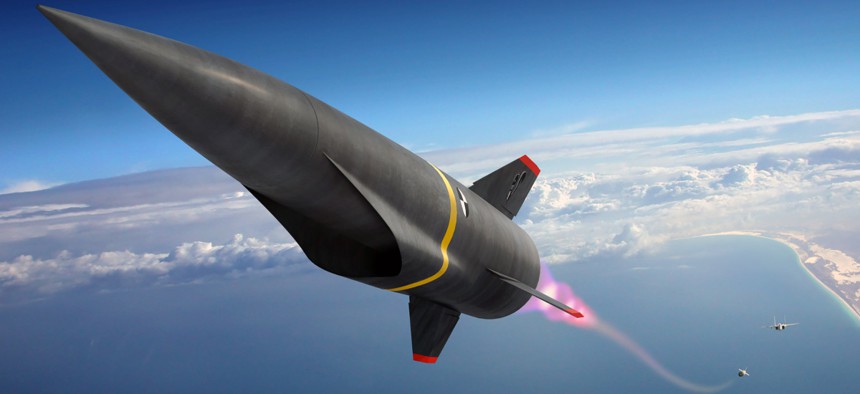
An Illustration of a hypersonic missile. U.S. Air Force
The Pentagon’s New R&D Chief Has a Mandate for Change
Michael Griffin has orders to concentrate the Defense Department’s diverse research and development efforts on a few key technologies.
The U.S. Defense Department is “organizing now for an an expeditious, output-oriented, exploration in research of...advanced technologies” to get emerging technologies like hypersonics, artificial intelligence, and directed energy into the field faster, Defense Secretary James Mattis testified on Thursday.
His new undersecretary for research and engineering, Michael Griffin, has the lead on what Mattis described as a department-wide effort to “concentrate” many, somewhat “diffuse” research and engineering initiatives “in a synergistic way.”
Griffin’s priorities for emerging technologies are: hypersonics (for offense and defense); directed energy; machine learning and artificial intelligence; quantum science, including encryption and computing; and microelectronics, he wrote in testimony submitted to Congress in April. “In all of these areas, we are establishing near, mid, and long term goals that are measurable,” said Griffin.
“Now we know what we need to focus on,” Mattis said on Thursday about Griffin’s efforts to organize the department’s wide-ranging cutting-edge research efforts.
Griffin has highlighted hypersonics as his key priority. Earlier this month, he told lawmakers that China’s rapid development in the area could limit the Pentagon’s ability to project power. “In my opinion today, the most significant advance by our adversaries has been the Chinese development of what is now, today, a pretty mature system for conventional prompt strike at multi-thousand kilometer ranges. With our current defensive systems, we will not see these things coming, and … they can come from any direction. We will not see them coming beyond several hundred kilometers of range. Once inside that range bucket, we have very little time left to respond,” he said in his April 17 appearance before the House Armed Services Committee.
In March, Steven Walker, the new director of the Defense Advanced Research Projects Agency, or DARPA, discussed how the United States was accelerating its development of hypersonic weapons with an aim of conducting initial engine testing by 2019. In April, Lockheed Martin won a $928 million contract for a “hypersonic, conventional, air-launched, stand-off weapon.”
But, Walker said, the United States still didn’t have enough testing facilities to keep up with Chinese efforts.
“We do need an infusion of dollars into our infrastructure to do hypersonics. What I really want to do is work with Mike Griffin…. and the new NASA administrator, to develop an infrastructure plan for hypersonics. It’s badly needed. Most of our programs at DARPA are testing at one facility and that’s NASA Langley right now. That’s just doing all it can to work 24/7 to do this work,” he said.
Gen. Joseph Dunford, the chairman of the Joint Chiefs of staff, noted in the Thursday hearing that U.S. testing and experimentation “has suffered” due to the high operational tempo of U.S. military activity in the Middle East. He said that restoring that ability to quickly test and experiment with prototypes would be a key focus of the department over the summer.
Mattis said that a willingness to move aggressively, particularly with prototype testing, was essential to quicker development and deployment of weapons. “As we speed this forward, that’s how we get them out into the hands of the troops fast. Not by having more studies done, but by actually having something developed [to] fly a hypersonic vehicle by X day.”




